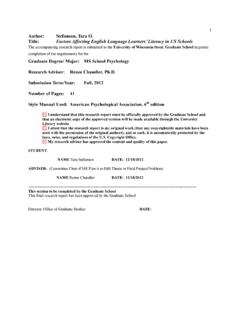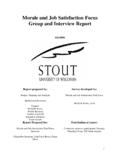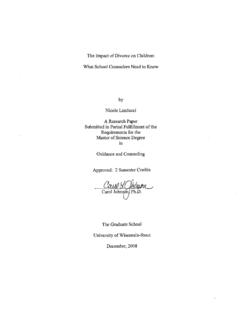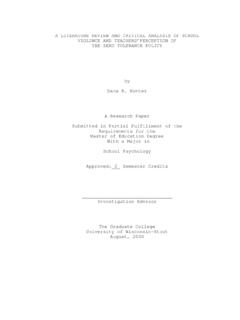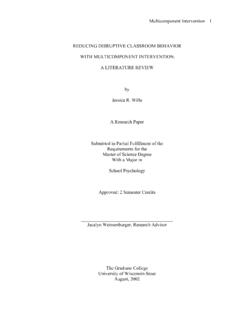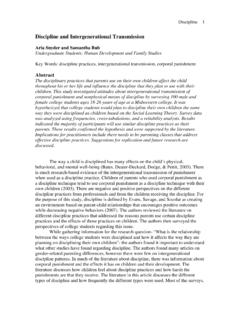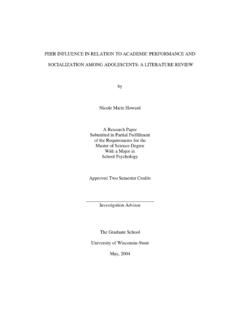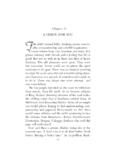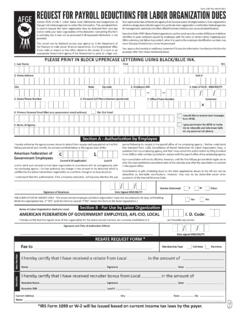Transcription of Factors Leading Youth To Gang 1 - UW-Stout
1 Factors Leading Youth To gang 1. Factors Leading HMONG Youth TO JOIN gang . By Kevin C. Lor A Research Paper Submitted in Partial Fulfillment of the Requirements for the Master of Education Degree With a Major in Guidance and Counseling-Mental Health & K-12. Approved: Two Semester Credits _____. Investigation Advisor The Graduate College University of Wisconsin-Stout September, 2003. The Graduate College University of Wisconsin-Stout Menomonie, Wisconsin 54751. Abstract Factors Leading Youth To gang 2. Lor Kevin C. (Last Name) (First) (Initial). Factors Leading Hmong Youth to Join Gangs (Title).
2 Guidance and Counseling-Mental Health & K-12, Dr. Louis Milanesi, 9/03 , 52. (Graduate major) (Research Advisor) (Date) (Page). American Psychological Association Manual Used in this Study This paper examines some of the elements that lead Youth to join gangs. A questionnaire developed by the investigator was distributed to gang members and at-risk Hmong Youth in two northern states. This questionnaire was developed in an attempt to assess some of the Factors that have a high probability of Leading Youth to join gangs to compensate for what is lacking in Hmong youths' life.
3 A 12-item questionnaire was developed and distributed to at-risk Hmong youths residing in two northern states. The questions were examined by calculating the percentage of males and females responding to different targeted areas. The questions were also examined to determine the internal validity between male and female subjects in responding to the different targeted areas. ACKNOWLEDGEMENTS. Factors Leading Youth To gang 3. I would like to thank all those people involved in helping me finish my research. First and foremost, I would like to thank my research advisor, Dr.
4 Louis Milanesi, for his patience and dedication to helping me complete my thesis. Second, I would like to express my deep appreciation to both Dave Schibline and Jeff Jenswold for their willingness to help. They both were great mentors who were incredibly patient and understanding throughout the whole process Third, I would like to thank my brother, Tou, for believing in me and always giving me positive encouragement. He has remained a constant source of support and encouragement through thick and thin. Fourth, I would like to thank my girlfriend for her tireless effort and dedication in helping me during the data collection.
5 All of your contributions, support, and encouragement are greatly appreciated. Last, but certainly not least, I would like to thank the UW-Stout Graduate College and Research Promotion Services for the student research grant. The grant helped cover some of my travel expenses and the duplication costs for this study. TABLE OF CONTENTS. Factors Leading Youth To gang 4. Title Page 1. Abstract 2. Acknowledgements 3. Table of Contents 4. Chapter 1: Introduction 6. Statement of the Problem 11. Definition of Terms 12. Chapter II: Review of Literature 14. Definition of gang 14.
6 gang Structure and Membership 16. gang Initiation 19. Individual 19. Low Self-Esteem 20. Family 21. School 24. Neighborhood 24. Economy 25. Media and Politic 26. Intelligence 26. TABLE OF CONTENTS (Continued). Factors Leading Youth To gang 5. Asian gang 27. Chapter III: Methodology 32. Population and Subjects 32. Instrumentation 32. Data Collection 32. Data Analysis 34. Limitations 34. Chapter IV: Results 35. Findings 35. Tables 36-46. Chapter V: Conclusion 47. Recommendations 48. References 51. Chapter I. Factors Leading Youth To gang 6. Introduction A dramatic increase in gang activity during the past decade caught most everyone by surprise and left many unprepared to speak in an informed way to the challenge it posed.
7 However, violence in America is nothing new. Even before the Nation declared its independence, outlaw groups with names like "The Sons of Liberty" formed in several colonial towns to express their opposition to the British rule (Brantley & DiRosa, 1994). As the nation grew, gangs emerged in the large urban centers that developed in the mid-west and on the west coast. Cities as diverse as Chicago and San Francisco have long histories of gang -related crimes (Di Rosa, 1994). European immigrants came to the United States in the early 1900s to seek a better life and better future.
8 These immigrants lacked the skills necessary to be productive in the mainstream and were exploited in the labor force and faced poverty and discrimination. The second generation of these immigrants were faced with cultural and identity crises. They then formed their own gangs for support and protection because they did not fit into the mainstream society (Wang, 1994). This is a pattern with every wave of immigrants who came to the United States. They all faced similar experiences of poverty and discrimination. After a couple of generations in America, most of the immigrants assimilated into the mainstream; and the problems became less severe.
9 In the early 1900s, the United States government established immigration priority and granted many Chinese naturalization in America when it received a flood of Chinese immigrants Factors Leading Youth To gang 7. into the United States. The number of Chinese immigrants grew dramatically in the 1960s as a result of this new law. Large cities where immigrants settled were not prepared to assist with the problems these immigrants brought with them. Many of the Chinese youths experienced racial tension in the form of unequal treatment and opportunity; therefore, crime and gang involvement became a serious problem for the communities.
10 Many of those Chinese youths started to form social support groups but later became involved in prostitution, drug dealing, and other criminal activities (Spergel, 1992). Since the end of the Vietnam War in 1975, the United States has received over a million refugees from the Southeast Asian countries. These immigrants had very little education and limited labor skills. These refugees found themselves in a strange society where they were not accepted due to their unique physical characteristics and their lack of productive labor market skills. One such group of refugee from one of those Southeast Asian countries is the Hmong.


